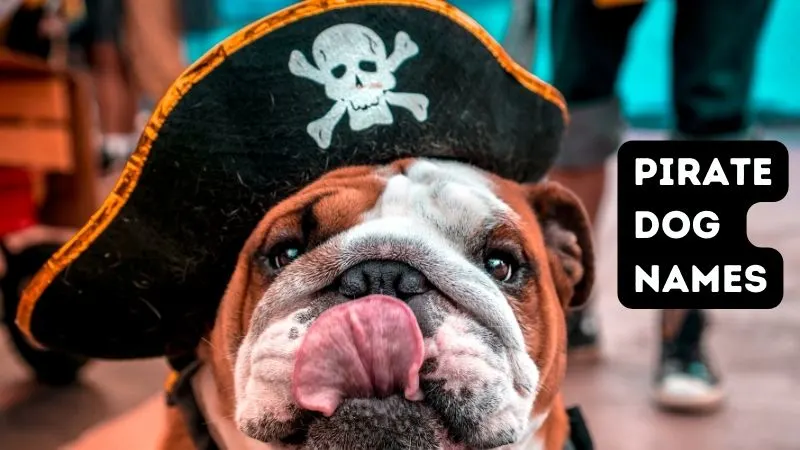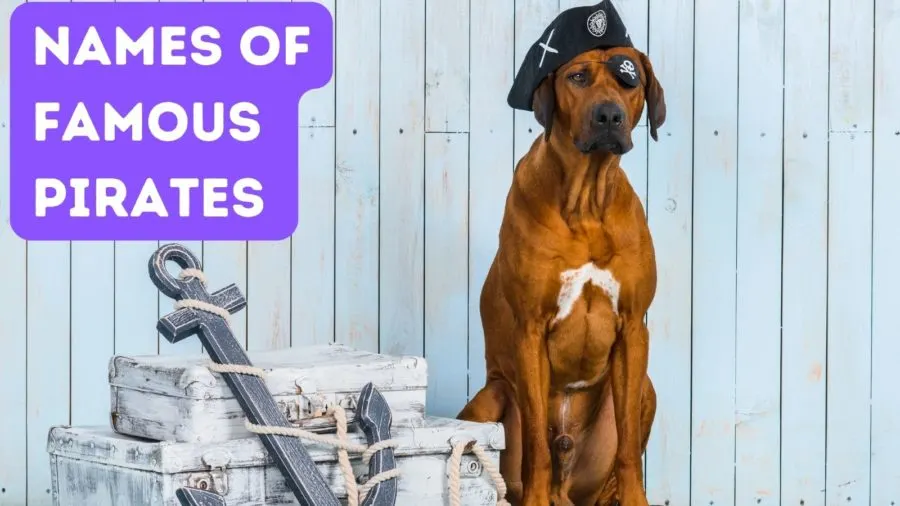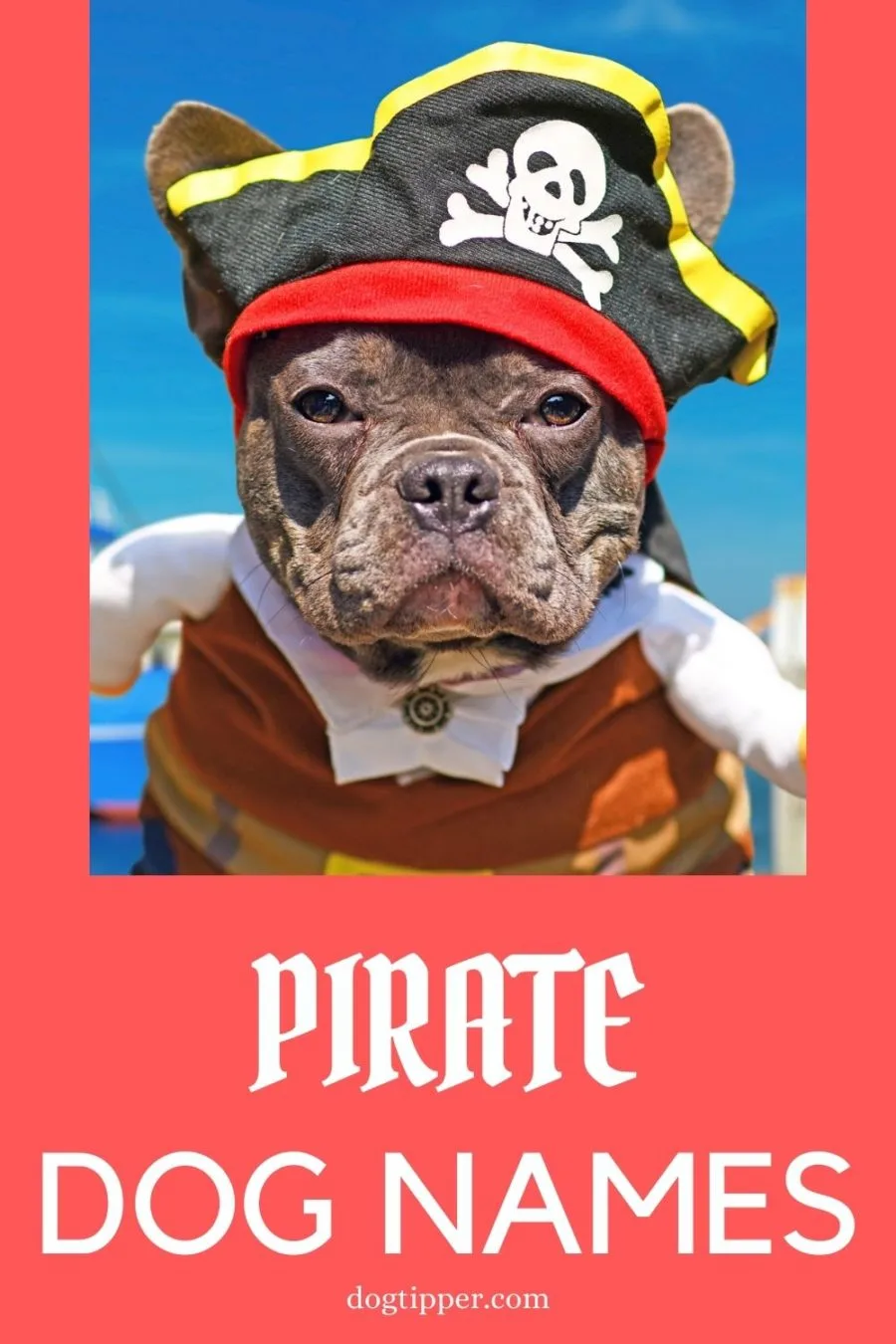Shiver me timbers: it’s time to find a dog name! If you are looking for a fun dog name for your new matey, we’ve got pirate dog names derived from favorite pirate words, pirates in books and movies, and real-life famous pirates and places. Avast ye!

Famous Pirate Phrases
You don’t have to wait for Talk Like a Pirate Day to consider one of these famous phrases associated with pirates as a dog name:
Ahoy: Now used as “hello” or to get someone’s attention, ahoy traces its roots to the Middle English Hoy, which came from the Dutch Hoi. (Did you know that Alexander Graham Bell originally wanted everyone to say “Ahoy-hoi” when answering the phone?)
Avast Ye: pay attention
Aye Aye: A term to show you have heard and understand what has been said.
Blimey: an expression of surprise
Bucko: a friend
Bumbo: Bumbo was a type of grog that pirates made.
Booty: Pirate treasure
Cap’n: Captain
Crossbones: The crossed bones appear on the pirates’ Jolly Roger flag.
Doubloon: Spanish gold coins
Grog: A mix of alcohol, usually rum, and water that was a favorite with pirates.
Hearties: friends
Jolly Roger: The infamous pirate flag. The pirate flag nicknamed the “Jolly Roger” comes from the French “joli rouge” — a hint that the first pirate flags weren’t black but red. A great choice among pirate dog names for a happy four-legged family member.
Kraken: A legendary sea monster.
Matey: A friend or a shipmate (or man’s best friend?)
Poop Deck: the back of the ship above the captain’s quarters
Salty Dog: The nickname for an “old salt” or someone who has spent much of his life at sea; also the name for a cocktail.
Savvy: used as a question to mean “Do you understand?”
Scallywag: someone new to pirating
Seadog: an old pirate
Shanty (or Chantey): A song sung by pirates as they worked.
Squiffy: intoxicated
Yo Ho Ho: Ever heard the ditty “Sixteen men on a dead man’s ship? Yo ho ho and a bottle of rum”? That ditty told the tale of a 16 pirates marooned on the British Virgin Islands’ Dead Chest with a single bottle of grog. The fight which ensued left no survivors.
Fictional Pirates

Barbossa: The pirate in Pirates of the Caribbean who commanded the crew of the undead.
Billy Bones: A fictional pirate from Robert Lewis Stevenson’s Treasure Island.
Black Dog: The nickname of a pirate in Treasure Island, Black Dog was also a character in Muppets Treasure Island, Muppets Wizard of Oz and Muppets Most Wanted.
Black Pearl: Captain Jack Sparrow’s pirate ship in Pirates of the Caribbean.
Bluebeard: Not to be confused with Blackbeard, Bluebeard was a fictional character (and not a very nice one!) He is remembered in St. Thomas, USVI in what is now called Bluebeard’s Castle.
Bootstrap Bill: Will Turner’s father in Pirates of the Caribbean
Calypso: The daughter of Atlas in Greek mythology; a sea nymph and goddess.
Davy Jones: The “sailors’ devil.” Davy Jones Locker was a euphemism for the bottom of the sea.
Flint: Captain Flint appears in the television series Black Sails, which takes place two decades before the events of Treasure Island.
Flying Dutchman: The ship manned by ghost captain Davy Jones in Pirates of the Caribbean. A fun pirate dog name for a dock diving Dutch Shepherd!
Hook: Captain Hook of Peter Pan fame.
Long John Silver: Treasure Island‘s one-legged pirate.
Neptune: The Roman name for the god of the seas.
One-Eyed Willie: The eyepatch-wearing pirate in The Goonies. (Did you know there’s one theory that some pirates wore eye patches not only because of the loss of an eye but because of the need to constantly go back and forth between above and below deck, thus preserving their night vision?)
Poochie: The prison dog with the keys that Jack Sparrow tries to lure to his cell in Fort Charles in Pirates of the Caribbean. The dog was portrayed by two dogs: Twister and Chopper.
Poseidon: The god of the seas in Greek mythology.
Sir Turtle: The pegleg swashbuckling turtle who is the mascot of Cayman Airways.
Sparrow: Captain Jack Sparrow in the Pirates of the Caribbean.
Treasure: Robert Louis Stevenson’s Treasure Island has become the bedrock on which much of the public’s knowledge of pirates is based. Published in 1883, the novel tells the story of a treasure map found in the belongings of a sea captain, a map that inspires the characters to head out in search of that treasure. Thanks to this classic novel, buried treasure is often considered synonymous with pirates, but in reality the buccaneers rarely buried their loot (although hurricanes and shipwrecks created many involuntary treasure sites throughout the Caribbean.)
Famous Pirate Names for Dogs

As long as there has been sea trade, there have been pirates, by one name or another. Dating back to the days of Greek and Roman excursions by sea, pirates have roamed the waters in search of easy money.
Barbary: The region of North Africa known as the Barbary Coast was a favorite with pirates until the early 1800s.
Blackbeard: A good choice among pirate dog names for a dog with black facial fur, this was the name by which pirate Edward Teach was best known. He earned his moniker due to a waist-length beard which he wore braided and tied with ribbons. Across his chest, he strapped numerous pairs of pistols–but he relied on his hat to bring real terror to those he attacked. In true pirate fashion which dictated that the more outrageous a man looked, the more he was feared, Blackbeard tucked hemp fuses beneath his hat, lighting them to produce a cloud of smoke as he approached.
Black Bart: Bartholomew “Black Bart” Roberts was a Welsh pirate, one of the most successful during the “Golden Age of Piracy” with 400 “prizes.”
Bonny: Anne Bonny, part of the crew of the notorious Calico Jack, was said to have fought as vigorously (and lived as wildly) as her male counterparts. Anne had previously been married before meeting the dashing Calico Jack and turning to a life as a pirate.
Brandy: King Charles decided to create a royal monopoly on sales of brandy in Jamaica’s Port Royal, using the profits to fortify and enlarge Fort Charles and to construct two smaller forts in the pirate outpost.
Buccaneer: The first pirates that headed to Tortuga smoked the meat on grills of green wood the French called boucans, making them boucaniers or, in English, buccaneers.
Calico: Perfect for the multicolored dog, Calico Jack was a notorious Caribbean pirate named for his striped pants.
When pirates crossed the Tropic of Cancer, many no longer used their last names, considering their old lives drowned by the latitudinal line.
Charles: Fort Charles in Port Royal, Jamaica. Its cannons still point to sea, guarding what was once one of the world’s wealthiest ports. A few visitors stroll the ramparts of this fort and tour its Maritime Museum for a look at some of the artifacts which have been recovered.
Corsair: The term for a Mediterranean pirate. Lord Byron penned The Corsair, the story of an Aegean pirate, which proved the public’s interest in the subject: the book became an instant bestseller, selling over 10,000 copies on its first day of publication. Bryon’s romantic portrait of the pirate lives on to this day:
That man of loneliness and mystery,
Scarce seen to smile, and seldome heard to sigh;
Whose name appals the fiercest of his crew
Lord Byron
Dancing Molly: A pirate sloop that was crewed by “petticoated pirates” — the wife and two daughters of the captain.
Drake: No, not the singer but the pirate. Sometimes the line between buccaneer and privateer was blurred, as in the case of Sir Francis Drake. The well-known explorer who circumnavigated the globe raided many Spanish ships, bringing home to loot to his Queen. When England was no longer at war with Spain, however, and Drake returned home with the bounty from a raid, he was disowned and had to go into hiding for two years. Only after his triumph in circumnavigating the globe did he return home a hero and gain his knighthood.
Fancy: The ship of pirate Henry Every.
Fermin: A pirate named Fermin Mundaca made the island of Isla Mujeres, Mexico his home.
Graywolf: Captain John Howard Graysmith was a pirate who commanded the schooner Graywolf and plundered treasure ships along the Spanish Main. He built Graycliff in the Bahamas; the mansion eventually became the headquarters for the American Navy when Nassau was captured by the soldiers. In 1844, Graycliff became Nassau’s first hotel and has been a favorite with celebrity visitors.
Havana: Treasure ships headed to Seville would all met in Havana, traveling from there in convoys as protection from pirates.
Jost: Jost (pronounced Yost) Van Dyke is an island in the British Virgin Islands named for a Dutch pirate. Jost Van Dyke is a real getaway, a Robinson Crusoe kind of place with nearly deserted beaches and coral reefs teeming with fish as colorful as neon signs.
Lafitte: Jean Lafitte, the most famous pirate who sailed from Louisiana.
Morgan: The most notorious of all the pirates of the Caribbean was Sir Henry Morgan. Most believe the Welshman came to the West Indies as an indentured servant, eventually becoming a licensed privateer. His raids–including his most famous attack in Panama as retaliation for raids on Jamaica–earned Morgan the favor of King Charles II. Morgan was knighted and became Deputy Governor of Jamaica.
Norman: Robert Louis Stevenson based much of his research on reality, including the setting for much of the action in Treasure Island. Most researchers believe that Norman Island, located in the British Virgin Islands, provided the inspiration for the book.
Privateer: Competing with the buccaneers were the privateers, looting pirates who worked under the sanctioning letter of their government. By maritime law, these crews could not be charged with piracy but they operated like the pirates: capturing vessels and plundering loot from the ships of opposing nations.
Redbeard: Hayreddin Barbarossa, an Ottoman corsair (or Mediterranean pirate).
Royal: Even a pirate had to avoid “all work and no play.” In the Caribbean, that meant a trip to Port Royal, Jamaica, a community of 8000 residents, located just off Kingston Harbour, once called “the wickedest city in Christendom,” a waystation for pirates who returned from their expeditions laden with gold, silver, and jewels–to be greeted by a thriving community of taverns, brothels, and gaming houses.
Rum: An extra strong rum called “kill-devil” was top choice for most pirates. Jamaica’s governor Sir Thomas Modyford wrote that “the Spaniards wondered much at the sickness of our people, until they knew of the strength of their drinks, but then they wondered more that they were not all dead.”
Sea Dog: The Sea Dogs were privateers authorized by Queen Elizabeth I.
Silver: Silver was used to make Pieces of Eight, the coins minted by the Spanish from the silver they obtained in the New World.
Singleton: In 1719, Daniel Defoe followed up the publication of his Robinson Crusoe with Captain Singleton, a novel presented as a pirate’s autobiography. Defoe’s research was far more than just academic; in 1683 he himself had been captured by Algerian corsairs. A good pirate name for a rescue puppy found as a singleton.
Tortuga: Many pirates lived on the small island of Tortuga, located off the north coast of Hispaniola (the large island shared by Haiti and the Dominican Republic). In the early 1600s, drifters and deserters had headed to this island to hunt wild hogs and cattle that lived on Hispaniola.
Watling: Notorious pirate Captain John Watling decided to set up camp in the Bahamas at San Salvador and proclaim the island his headquarters. The English buccaneer used the island as a hideaway during the 17th century but Watling’s influence long outlived him, and the island took on the name Watling’s Island. Finally in 1925 the name of San Salvador was restored.
Pin It to Remember These Pirate Dog Names!

- Review: Jimmy BX7 Pro Anti-Mite Vacuum Cleaner - December 16, 2024
- 🎉 GIVEAWAY: Lord of the Pets Portrait of Your Dog! - November 26, 2024
- Review: Lord of the Pets Portraits - November 17, 2024
